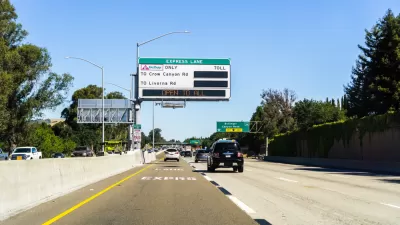To the chagrin of many Orange County transportation leaders, two express lanes will be added to each direction on a 14-mile stretch of the 405 (San Diego) Freeway, one through conversion, and a general purpose lane funded in part by Measure M added.
"After fighting toll lanes for years, Orange County transportation officials on [Apr. 27] said they couldn't fight the state any longer and gave in, allowing toll lanes as part of a $1.7 billion expansion project of Interstate 405," writes Erika Aguilar, Orange County reporter for KPCC, Southern California Public Radio." Better that the Orange County Transportation Authority (OCTA) do it than Caltrans, stated OCTA chair and Irvine city councilman Jeffrey Lalloway.
It's helpful to refer our July post, "Caltrans Overrides OCTA: 405 Freeway Widening Must Include Toll Lane" to put the controversy in perspective. The dispute is not over widening freeways but about charging drivers who use the additional lane(s), regardless that most lanes remain "free". Huntington Beach Mayor Matthew Harper described it best last summer:
"The state of California and those in Sacramento are trying to implement a concerted agenda to have layers of taxes, fees and tolls to extract dollars out of everyday drivers," he said. "I think once voters realize what's coming down at them, they're going to rebel and people are going to want to keep the freeways free." [Planetizen, July 29, 2014]
As noted on the project a year earlier, the paradox is that the nation's first high occupancy toll (HOT) lanes, as they are still commonly called, were built in Orange County in 1996, now known as the 91 Express Lanes, and operated by OCTA.
According to the OCTA news release of Apr. 28, "the San Diego (I-405) Freeway between Costa Mesa and the Los Angeles county line [see map], an area traveled by more than 370,000 vehicles a day, (is) the busiest stretch of highway in the nation."
"The move mirrors decisions by transportation officials in Los Angeles a few years ago, when they caved in to state officials and added toll lanes to the 110 Harbor Freeway and then the Interstate 10 El Monte freeway the following year," writes Aguilar.
The LA express lanes have proven so popular that LA Metro is considering expanding them.
As a result of the OCTA vote, "Lalloway said his agency maintains local control over setting toll rules [sic], fees and decisions on what [to do] with any toll revenues collected, rather than letting the state do it and have the money go statewide," writes Aguilar.
“These revenues will stay in Orange County,” he said. “They’ll stay in your cities to fix your roads, to help you with intersections. That was a deal breaker for us.”
The pricetag amounts to over $121 million per mile.
"The Measure M project, being constructed in cooperation with Caltrans, will be funded by a combination of local, state and federal funds, with the toll lane portion of the project financed and paid for by those who choose to pay a toll and use the 405 Express Lanes," according to OCTA. Aguilar writes that Caltrans will also contribute to the cost of toll lane construction.
The Orange County widening of the 405 Freeway is not to be confused with the "widening the 405 (to add one solitary carpool lane on the freeway's northbound side" in Los Angeles, posted here in July, 201l, "and brought us the revelatory event known as 'Carmageddon'", wrote former Planetizen editor, Jonathan Nettler of in August, 2013.
Hat Tip: Angie Schmitt of Streetsblog USA.
FULL STORY: After long fight, Orange County transportation officials agree to toll lanes on I-405

Planetizen Federal Action Tracker
A weekly monitor of how Trump’s orders and actions are impacting planners and planning in America.

Maui's Vacation Rental Debate Turns Ugly
Verbal attacks, misinformation campaigns and fistfights plague a high-stakes debate to convert thousands of vacation rentals into long-term housing.

Restaurant Patios Were a Pandemic Win — Why Were They so Hard to Keep?
Social distancing requirements and changes in travel patterns prompted cities to pilot new uses for street and sidewalk space. Then it got complicated.

In California Battle of Housing vs. Environment, Housing Just Won
A new state law significantly limits the power of CEQA, an environmental review law that served as a powerful tool for blocking new development.

Boulder Eliminates Parking Minimums Citywide
Officials estimate the cost of building a single underground parking space at up to $100,000.

Orange County, Florida Adopts Largest US “Sprawl Repair” Code
The ‘Orange Code’ seeks to rectify decades of sprawl-inducing, car-oriented development.
Urban Design for Planners 1: Software Tools
This six-course series explores essential urban design concepts using open source software and equips planners with the tools they need to participate fully in the urban design process.
Planning for Universal Design
Learn the tools for implementing Universal Design in planning regulations.
Heyer Gruel & Associates PA
JM Goldson LLC
Custer County Colorado
City of Camden Redevelopment Agency
City of Astoria
Transportation Research & Education Center (TREC) at Portland State University
Jefferson Parish Government
Camden Redevelopment Agency
City of Claremont




























